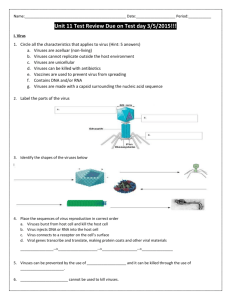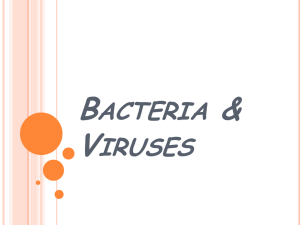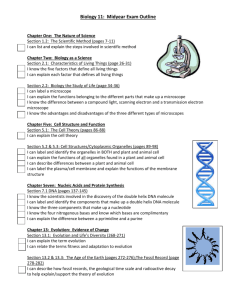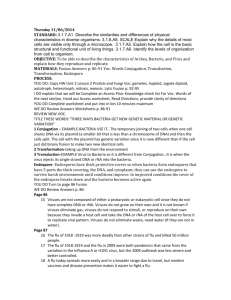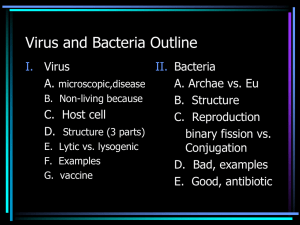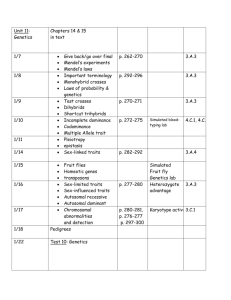ch.24 & 25 Baceria and Virus practice test
advertisement
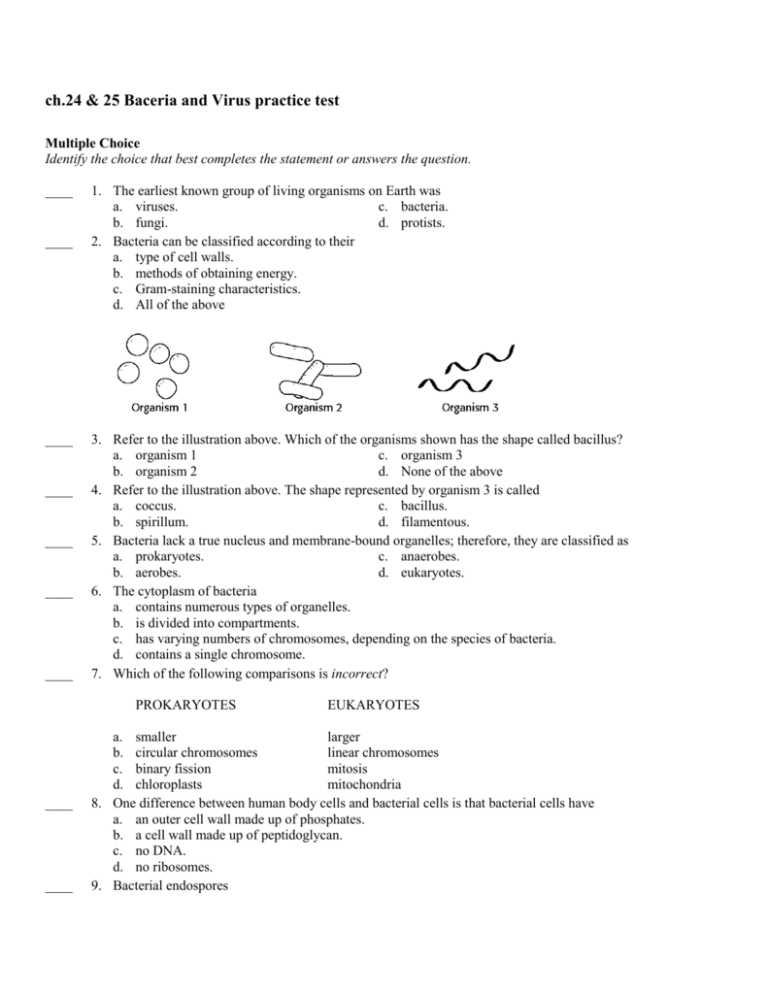
ch.24 & 25 Baceria and Virus practice test Multiple Choice Identify the choice that best completes the statement or answers the question. ____ ____ ____ ____ ____ ____ ____ 1. The earliest known group of living organisms on Earth was a. viruses. c. bacteria. b. fungi. d. protists. 2. Bacteria can be classified according to their a. type of cell walls. b. methods of obtaining energy. c. Gram-staining characteristics. d. All of the above 3. Refer to the illustration above. Which of the organisms shown has the shape called bacillus? a. organism 1 c. organism 3 b. organism 2 d. None of the above 4. Refer to the illustration above. The shape represented by organism 3 is called a. coccus. c. bacillus. b. spirillum. d. filamentous. 5. Bacteria lack a true nucleus and membrane-bound organelles; therefore, they are classified as a. prokaryotes. c. anaerobes. b. aerobes. d. eukaryotes. 6. The cytoplasm of bacteria a. contains numerous types of organelles. b. is divided into compartments. c. has varying numbers of chromosomes, depending on the species of bacteria. d. contains a single chromosome. 7. Which of the following comparisons is incorrect? PROKARYOTES ____ ____ EUKARYOTES a. smaller larger b. circular chromosomes linear chromosomes c. binary fission mitosis d. chloroplasts mitochondria 8. One difference between human body cells and bacterial cells is that bacterial cells have a. an outer cell wall made up of phosphates. b. a cell wall made up of peptidoglycan. c. no DNA. d. no ribosomes. 9. Bacterial endospores ____ 10. ____ 11. ____ 12. ____ 13. ____ 14. ____ 15. ____ 16. ____ 17. ____ 18. ____ 19. a. occur where there is plenty of available food. b. allow certain species to survive harsh environmental conditions. c. are similar to human tumors. d. can cause growth abnormalities in plants. Which of the following are used by at least some bacteria for movement? a. pili b. flagella c. cytoplasmic projections d. All of the above Autotrophic eukaryotes and autotrophic prokaryotes differ in that some autotrophic prokaryotes a. are decomposers. b. can use the energy from inorganic chemicals. c. have membrane-bound organelles. d. cannot manufacture their own food. Which of the following conditions would be unsuitable for any kind of bacteria to grow? a. temperature of 110ºC (230ºF) b. absence of oxygen c. pH of 5 d. None of the above A pathogen is an agent that is a. beneficial to humans. b. harmful only to plants. c. harmful to living organisms. d. nearly extinct. Which of the following foods is not a fermentation product of bacteria? a. sour cream c. milk b. a pickle d. yogurt Antibiotics a. include penicillin and tetracycline. b. may prevent bacteria from making new cell walls. c. can be effective treatments for bacterial diseases. d. All of the above All of the following are habitats of archaea except a. volcanic vents. b. intestinal tract of cows. c. salt lakes. d. human skin. Which of the following is not a way of preventing a foodborne illness at home? a. washing kitchen utensils thoroughly in cold water b. keeping cooked and raw foods separate during storage c. washing fresh fruits and vegetables before eating them d. refrigerating leftovers promptly Viruses are considered nonliving because a. they cannot reproduce by themselves. b. they are not made up of cells. c. they cannot carry out metabolism by themselves. d. All of the above Biologists now know that viruses a. are the smallest organisms. ____ 20. ____ 21. ____ 22. ____ 23. ____ 24. ____ 25. ____ 26. ____ 27. ____ 28. ____ 29. ____ 30. b. consist of a protein surrounded by a nucleic acid coat. c. contain RNA or DNA in a protein or lipid-protein coat. d. all form the same crystalline shape. The capsid of a virus is the a. protective outer coat. b. cell membrane. c. nucleus. d. cell wall and membrane complex. All viruses have a. cytoplasm. c. mitochondria. b. ribosomes. d. None of the above Scientists first began to study viruses because they a. were seen through a microscope. b. could not be seen but caused disease. c. formed crystals. d. were made of cells. Viruses that use reverse transcriptase to cause their host cells to transcribe DNA from an RNA template are called a. bacteriophages. c. retroviruses. b. antibodies. d. capsoviruses. Which of the following contains only RNA? a. a prion c. a viroid b. a virus d. All of the above Unlike viruses, prions a. are capable of reproducing outside of a host cell. b. are composed only of protein. c. can cause brain infections. d. can be treated with antibiotics. A typical virus consists of a. a protein coat and a cytoplasm core. b. a carbohydrate coat and a nucleic acid core. c. a protein coat and a nucleic acid core. d. a polysaccharide coat and a nucleic acid core. Animal viruses often infect only specific host cells because a. the virus must have the same DNA as the host cell. b. the host cell must have specific receptors for proteins on the virus surface. c. viruses have receptors for host cell glycoproteins. d. the enzymes of the virus can attach only to specific host cells. In which cell cycle(s) does viral DNA become integrated into the host cell’s DNA? a. lytic b. lysogenic c. neither lytic nor lysogenic d. both lytic and lysogenic Antibiotics are ineffective against viral infections because a. host cells protect the viruses. b. viruses have enzymes that inactivate the antibiotics. c. antibiotics interfere with cellular processes that viruses do not perform. d. viral protein coats block the antibiotics from entering the virus. Which of the following is not a viral disease of humans? ____ 31. ____ 32. ____ 33. ____ 34. ____ 35. a. hepatitis b. SARS c. shingles d. All of the above are viral diseases of humans. Which of the following is not linked to cancer? a. Ebola virus c. hepatitis B virus b. human papillomavirus d. Epstein-Barr virus Which of the following human activities is most closely associated with the emergence of viruses not previously seen in humans? a. absence of a vaccination program b. crowded living conditions c. clearing of forests for housing d. eating uncooked meat HIV causes AIDS by a. converting a proto-oncogene to an oncogene. b. damaging a person’s blood vessels. c. destroying the covering of a person’s nerves. d. gradually destroying a person’s immune system. Which of the following is not a vector of viral diseases? a. mosquitoes c. prions b. ticks d. humans Most scientists believe that viruses first appeared on Earth ____ living cells appeared. a. after b. a very long time before c. at the exact time when d. immediately before Completion Complete each statement. 36. Spherical bacteria are called ____________________. 37. Rod-shaped bacteria are called ____________________. 38. The procedure used to distinguish between two types of bacterial cell wall composition is called ____________________. 39. Protective structures that some bacteria may form under harsh conditions are ____________________. 40. Bacteria that get carbon from other organisms are called ____________________. 41. A(n) ____________________ is a substance that can be obtained from bacteria or fungi and can be used as a drug to fight pathogenic bacteria. 42. Many bacteria are ____________________ and must have oxygen to live, whereas other bacteria are ____________________ and cannot live where oxygen is present. 43. An enzyme called _________________________ manufactures DNA that is complementary to a virus’s RNA. 44. ____________________ are viruses that infect bacteria and have a polyhedral head and a helical tail. 45. The virus that causes AIDS is called _________________________. Essay 46. Explain the difference between Gram-positive bacteria and Gram-negative bacteria. Write your answer in the space below. 47. Why are nitrogen-fixing bacteria important to Earth’s ecosystems? Write your answer in the space below. 48. Suggest a reason why bacteria that are resistant to antibiotics are becoming common in hospitals. Write your answer in the space below. 49. Explain why viruses are not considered to be living organisms, and why they are nonetheless included in the study of biology. Write your answer in the space below. Problem 50. A new disease has suddenly appeared and scientists are trying to determine whether the disease agent is a virus or a bacterium. They collect the following information: 1. 2. 3. 4. 5. The disease can be transmitted through the air. The disease agent is too small to be seen under a light microscope. There are no known antibiotics that are effective against the disease. The genetic material of the disease agent is DNA. The disease agent cannot be cultured using any known culture medium. Is the disease agent most likely a bacterium or a virus? Explain your answer. Write your answer in the space below.


